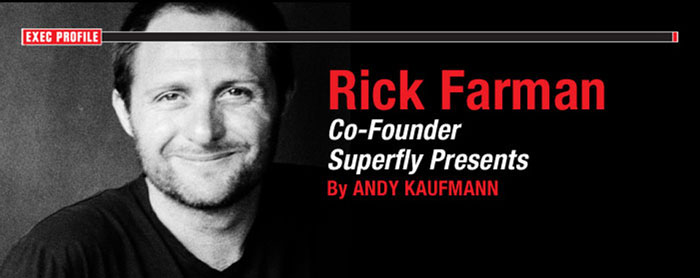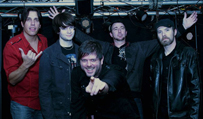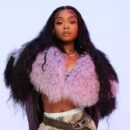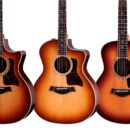Rick Farman
Co-Founder, Superfly Presents
Years with Company: 17
Web: http://superflypresents.com
Clients: Bonnaroo, Outside Lands, Yahoo, PayPal, Google, Intel, Pabst Blue Ribbon, Jet Blue
BACKGROUND: Superfly Presents is the entity behind Bonnaroo. Besides the other festivals they’ve created, Superfly are leaders in the realm of branding, helping companies create immersive experiences that forge meaningful connections with customers.
Following the Music
I went to Tulane University. Prior to that, I had been a music fan and a fledgling musician. When I got to New Orleans, I fell deeper in love with music. I realized being a musician wasn’t going to be my path, but I was passionate about helping bands. I started working at Tipitina’s, helping the booking agent. I was doing the marketing, primarily, and kind of giving suggestions on booking. The guy who was the booking agent [Jonathan Mayers] had just graduated college. He and I became good friends and recognized we had this entrepreneurial bent. When new people bought the club, we left to produce our own shows.
Creating Brands
For the first couple years, we really focused on special events. We did, for a while, promote regular concerts. We recognized our passion was on things where we could create intellectual property, a brand and a whole look, feel and community around an event, rather than just one-off concerts. That didn’t, at the end of the day, fulfill our creative desires or business ambitions, so we backed away from doing that. That was when we started to coalesce around the idea for Bonnaroo.
For the Fans
We would produce somewhere in the neighborhood of 30 to 50 concerts during the Jazz Fest time-period of two weekends, selling in the neighborhood of 30,000-40,000 tickets. We recognized that same audience would probably be excited to go to a more immersive camping festival, so we set out to fill that void. SFX was buying up all the regional promoters and made us think that being a regular concert promoter maybe isn’t the best path. That consolidation affected the product that was being put out. Being fans ourselves who were really on the ground, we noticed a lot of that, so we sort of designed Bonnaroo around being the opposite of that.
Rising With Technology
This also coincided with the explosion of digital music and the iPod being launched, so you had a situation where people’s tastes broadened and the format of the festival and the format of listening to your playlists, those things worked really well together. You also had early social media, things like message boards and listservs. The bands we were working with were very savvy around the use of new media, because they had fan bases that were on the cutting edge in using technology to communicate, so there was already a built-in network to get the word out.
Offering a Diverse Experience
There was a desire at the beginning for [Bonnaroo] to encompass a variety. We knew that if you’re going to keep people entertained for three or four days, you need to do some things other than just music. We’re going to put on a big party and it can’t be one-dimensional. It wasn’t until we started to go to other festivals [around the globe] that we started to put the pieces together of what we could do.
I went to a festival called Lowlands in Holland. Instantly, I saw two things that we brought over. One was the silent disco and another was the comedy tent.
Reflecting the Region
Outside Lands was born out of the idea that San Francisco is one of the great music markets in the country. It’s a place that inspired a lot of the music that inspired us. We were looking for opportunities in a more urban environment and it seemed crazy there wasn’t already a great festival in San Francisco. Because of that, we focused on how to make something happen there. We had a successful first year, had a couple years where we were still figuring out what was going to make it tick. The last three years, we’ve sold out in advance.
A big part of the event’s success is the identity we gave it. It’s representative of what the Bay Area has to offer. We’re in this beautiful location. We have amazing food. We serve over 150 different wines, 70 different beers. We have amazing art, both [visual] and performance. Those are kind of the pillars of culture and entertainment in the Bay area.
Getting On the Bill
We’re certainly calling on a lot of bands, but we’re mainly working through relationships we have with agents and managers. We make some exceptions, particularly for [artists] that might be in Nashville or the general Tennessee area, but by and large your band has to have a national touring profile. When you’re ready, you’ll know how to [get onto a bill] because your agent or manager or whatever other contact knows the ropes and how to present something properly.
A Festival of Your Own
It starts with why. What are you looking to accomplish? Is there something you don’t think is being done that audiences would be excited about? It’s really important to have a clear idea of what you want to produce. Saying, hey, I want to put on a festival, is not really enough. It’s understanding what is the opportunity you can bring to the table.
Sensible Branding
The consolidation of the business with SFX caused there to be not the greatest fan experience. A big part of that was sponsorship. You saw a lot of overt sponsorships that were not done in any sort of integrated way. It was just smacking a huge banner or “Presented By” on something. We were not interested in that. Instead of using an outside sponsorship agency, we decided to hire staff to sell and execute sponsorships that would happen at our events. We created a base, guiding principle that we use to evaluate whether it made sense for a brand to be part of one of our events or not. And that’s basically – why are they here? What are they adding? What is the fan getting out of said brand being there?
Brands as Relevant Cultural Experiences
A lot of the brands we worked with had great results. We started having people on the brand and agency side ask if we could help them do things outside of our events. We started to dabble in it and then about three years ago we made a commitment to say, look, here’s a real business. We started to have people who were at bigger agencies say, hey, I’d love to come work with you guys. It’s grown to about 50% of our revenue.
More Than the Music Business
We don’t look at ourselves as concert producers. We don’t look at ourselves as being in the music business. It makes us different from a lot of our contemporaries. We’re looking to build this business in a way that’s more like a media company, where you’re reaching out to audiences on a variety of levels. We’re working with artists and advertisers on a regular basis to create great experiences and promote product.
Target Yourself
We genuinely care about the experience of the people we’re interacting with, whether that be fans, clients or artists. We got into it because we were passionate about turning people on to music. Then we got passionate about creating a meaningful experience for people. We were doing things we wanted to be a part of. When you’re willing to do things that are in your sphere, things you understand inherently because they’re targeted for you, success usually follows. That’s kind of been our recipe.










